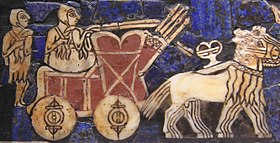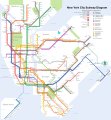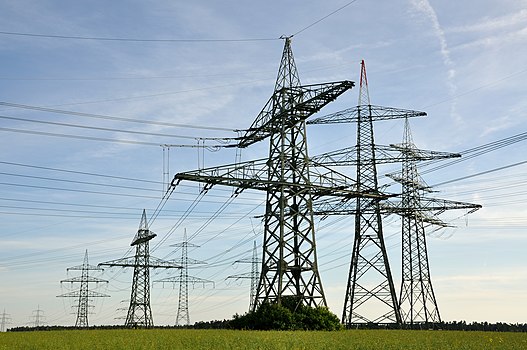Portal:Technology

Technology is the application of conceptual knowledge to achieve practical goals, especially in a reproducible way. The word technology can also mean the products resulting from such efforts, including both tangible tools such as utensils or machines, and intangible ones such as software. Technology plays a critical role in science, engineering, and everyday life.
Technological advancements have led to significant changes in society. The earliest known technology is the stone tool, used during prehistory, followed by the control of fire—which in turn contributed to the growth of the human brain and the development of language during the Ice Age, according to the cooking hypothesis. The invention of the wheel in the Bronze Age allowed greater travel and the creation of more complex machines. More recent technological inventions, including the printing press, telephone, and the Internet, have lowered barriers to communication and ushered in the knowledge economy. (Full article...)
Recognized articles -
The Q4 bus route constitutes a public transit corridor running along Merrick Boulevard and the easternmost portion of Linden Boulevard in southeastern Queens, New York City. The route runs from the Jamaica Center–Parsons/Archer station to Cambria Heights near the Queens–Nassau County border. The Q4 also provides limited-stop service along the corridor during peak weekday hours. The route is now operated by MTA Regional Bus Operations under the New York City Transit brand.
What is now the Q4 began service in November 1919, running from Jamaica to 201st Street in St. Albans. The franchise was extended to 223rd Street in Cambria Heights in 1931. The Q4 was originally operated by Bee-Line Incorporated and later the North Shore Bus Company until 1947. The Jamaica terminal has been changed several times throughout the route's history. (Full article...)
The Verrazzano-Narrows Bridge (/ˌvɛrəˈzɑːnoʊ/ VERR-ə-ZAH-noh; also referred to as the Narrows Bridge, the Verrazzano Bridge, and simply the Verrazzano) is a suspension bridge connecting the boroughs of Staten Island and Brooklyn in New York City, United States. It spans the Narrows, a body of water linking the relatively enclosed New York Harbor with Lower New York Bay and the Atlantic Ocean. It is the only fixed crossing of the Narrows. The double-deck bridge carries 13 lanes of Interstate 278: seven on the upper level and six on the lower level. The span is named for Giovanni da Verrazzano, who in 1524 was the first European explorer to enter New York Harbor and the Hudson River.
Engineer David B. Steinman proposed a bridge across the Narrows in the late 1920s, but plans were deferred over the next twenty years. A 1920s attempt to build a Staten Island Tunnel was aborted, as was a 1930s plan for vehicular tubes underneath the Narrows. Discussion of a tunnel resurfaced in the mid-1930s and early 1940s, but the plans were again denied. In the late 1940s, urban planner Robert Moses championed a bridge across the Narrows as a way to connect Staten Island with the rest of the city. Various problems delayed the start of construction until 1959. Designed by Othmar Ammann, Leopold Just, and other engineers at Ammann & Whitney, the bridge opened on November 21, 1964. The lower deck opened in 1969 to accommodate increasing traffic loads. The bridge was refurbished in the 1990s and again in the 2010s and 2020s. (Full article...)
On Sunday 10 March 1946 a Douglas DC-3 aircraft departed from Hobart, Tasmania for a flight to Melbourne. The aircraft crashed into the sea with both engines operating less than 2 minutes after takeoff. All twenty-five people on board the aircraft died. It was Australia's worst civil aviation accident at the time.
An investigation panel was promptly established to investigate the accident. The panel was unable to conclusively establish the cause but it decided the most likely cause was that the automatic pilot was inadvertently engaged shortly after takeoff while the gyroscope was caged. The Department of Civil Aviation took action to ensure that operation of the automatic pilot on-off control on Douglas DC-3 aircraft was made distinctive from operation of any other control in the cockpit, and that instructions were issued impressing on pilots that gyroscopes should be un-caged prior to takeoff. (Full article...)
The GE E60 is a family of six-axle 6,000 hp (4.5 MW) C-C electric locomotives made by GE Transportation Systems (GE) between 1972 and 1983. The E60s were produced in several variants for both freight and passenger use in the United States and Mexico. GE designed the locomotive for use on the Black Mesa and Lake Powell Railroad (BM&LP), a dedicated coal-hauling route in Arizona, which began operation in 1973. That same year GE adapted the design for high-speed passenger service on Amtrak's Northeast Corridor. The largest customer was Ferrocarriles Nacionales de México (NdeM), the state-owned railroad in Mexico, which bought 39 for a new electrification project in the early 1980s.
The E60s were successful in the coal-hauling role. They ran on the BM&LP for decades and remain in use on several mining railroads in the Western United States. The passenger variants failed in their intended role. Problems with the truck design caused derailments above 90 miles per hour (140 km/h), rendering the locomotives unusable for high-speed service. By the end of the 1970s Amtrak abandoned the E60 in favor of EMD AEM-7 locomotives manufactured by Electro-Motive Division. In Mexico, the NdeM's project was delayed into the 1990s, then scrapped after three years of use. Most of the NdeM's electric locomotives never ran and were traded back to GE for diesels. Some were sold to various mining railroads. (Full article...)

State Route 121 (SR 121) is a state highway located entirely in Thurston County, Washington, United States. The highway serves Millersylvania State Park, forming a 7.67-mile (12.34 km) loop between two interchanges with Interstate 5 (I-5) near Maytown. It is an auxiliary route of U.S. Route 12 (US 12).
The highway follows roads constructed in the early 20th century and maintained by the Thurston County government until their incorporation into the state highway system. The state government created Secondary State Highway 1M (SSH 1M) in 1937, initially connecting Rochester to Tumwater before its north end was truncated to Maytown in 1959. SSH 1M was renumbered in 1964 to the short-lived SR 801, which was then replaced by SR 121 in 1967. The Rochester–Maytown section of SR 121 was replaced by the route through Millersylvania State Park in 1991, severing its connection to US 12. (Full article...)
![Image 1 One of the concrete bus shelters, located near Old Parliament House Concrete bus shelters are considered an icon of Australia's capital city Canberra. Installation of the cylindrical bus shelters began in 1975 and continued into the early 1990s. At least 477 were purchased, of which 455 remained in use by ACTION buses as of 2016[update]. The bus shelters are an example of brutalist architecture, and were designed for the National Capital Development Commission. They have proved to be hard wearing, but problems with their windows and a lack of lighting make them uncomfortable to use at times. Several variants of the design were developed, and some were installed in other cities. (Full article...)](http://upload.wikimedia.org/wikipedia/en/d/d2/Blank.png)












![Image 12 Movable type Photo credit: Willi Heidelbach A composing stick and movable type, the system of printing and typography using pieces of metal type, made by casting from matrices struck by letterpunches. The text on the stick reads, "The quick brown fox jumps over the lazy dog and feels as if he were in the seventh heaven of typography together with Hermann Zapf, the most famous artist of the" [sic]. More selected pictures](http://upload.wikimedia.org/wikipedia/commons/thumb/a/ae/Metal_movable_type.jpg/120px-Metal_movable_type.jpg)


























































